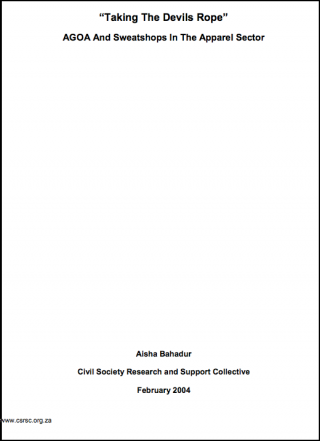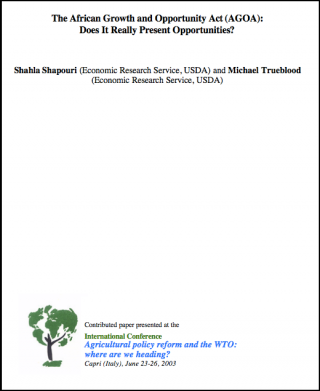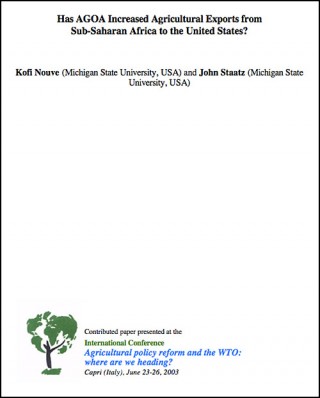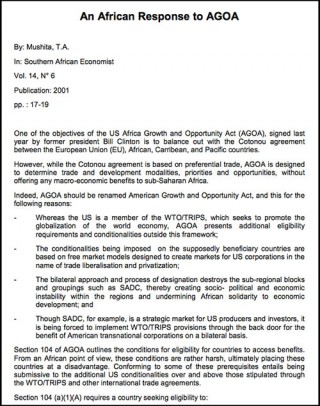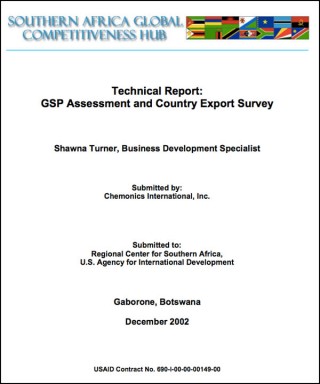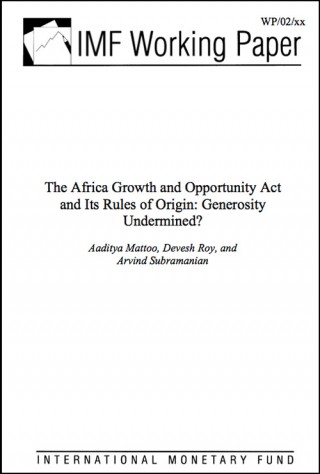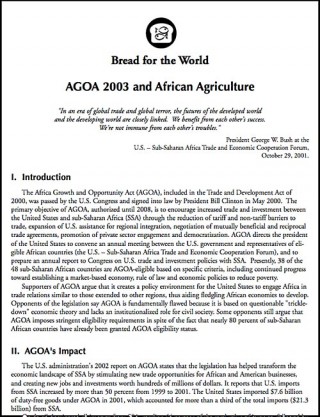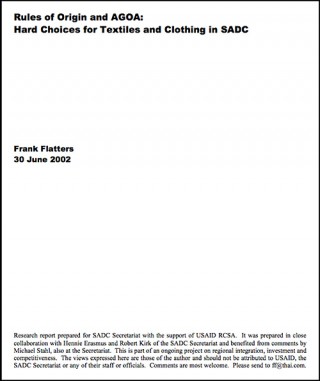Research Documents
"Taking The Devils Rope" - AGOA And Sweatshops In The Apparel Sector
In the last three years the apparel sector in Sub Saharan Africa has experienced considerable growth with the introduction of the African Growth and Opportunity Act (AGOA). Much of the investment in Southern Africa has been by Asian multinational companies that supply large retailers in the US. Research has, however, consistently shown that there are two sides to every story. This report deals with some of the less-favourable aspects of the clothing industry.
The African Growth and Opportunity Act (AGOA): Does it really present opportunities?
Paper presented at the International Conference "Agricultural policy reform and the WTO: where are we heading?" This paper attempted to address three main questions about AGOA: The first question looks at how well the market access provisions in AGOA match up with the structure of African exports prior to its enactment. The second question is related to the effectiveness of the program, and the third question concerns what economic theory would have predicted thus far.
Has AGOA increased agricultural exports from Sub-Saharan Africa to the United States? 2003
Paper presented at the International Conference "Agricultural policy reform and the WTO: where are we heading?" AGOA provides preferential access to Africa's products in US markets. While proponents expect that AGOA will expand Africa's exports to the US, opponents argue that such increases are unlikely, particularly regarding agricultural exports. This paper offers new empirical evidence that is inconclusive regarding the impact of AGOA on African exports to the US.
The initial and potential impact of preferential access to the US market under AGOA (World Bank-Brenton)
The ability to export clothing products under preferences with liberal rules of origin is the key factor currently determining whether the African Growth and Opportunity Act (AGOA) has a significant impact on non-oil exporting African countries. At present only a small number of countries receive substantial benefits and least developed countries that do not receive preferences for clothing have yet to see an impact of AGOA on their overall exports. This paper—a product of the World Bank's International Trade Department, Poverty Reduction and Economic Management Network - is part of a larger effort in the network to analyze the impact of trade preferences.
UNCTAD: Recent initiatives in favour of LDCs
A preliminary impact assessment undertaken by UNCTAD in 2003 on the main recent initiatives in favour of Least Developed Countries (LDCs) in the area of preferential market access. This document has been prepared to facilitate the debate at the fiftieth regular session of the Trade and Development Board on the benefits effectively derived from least developed country status. It analyses the benefits effectively derived from LDC status … and the expected impact of the most recent initiatives in favour of LDCs in the area of preferential market access, inter alia the “Everything But Arms” initiative, the African Growth and Opportunity Act (AGOA) and other such initiatives.
Article: An African response to AGOA (2001)
Short article on AGOA that was published in "The Southern African Economist", Vol 14, No6, pp 17-19, in 2001.
AGOA, agricultural practice and trade - 2001
Article published in the Southern African Political & Economic Monthly (SAPEM).
Technical Report: GSP assessment and country export survey - Tradehub
Under the preceding RAPID project, Southern Africa Global Competitiveness Hub advisors conducted a GSP Assessment and Export Survey in every SADC country with the exception of South Africa and Mauritius. The purpose of this exercise was to determine which products under AGOA could be exported to the US. For each country, the Hub has compiled a report on products that are currently exported in the region or other international markets as well as goods that could be produced but are not. The recommendations are based on interviews with key public and private sector officials, site visits and the list of duty/quota free AGOA GSP items. The GSP Assessment and Export Survey is by no means an exhaustive study and was designed to provoke thought and discussion about export diversification and provide a foundation for further investigation. The report will also serve in part as the basis for developing national AGOA strategies in each SADC country.
IMF Report - AGOA and its Rules of Origin: Generosity undermined?
This paper describes the United States recently enacted Africa Growth and Opportunity Act (AGOA) and assesses its quantitative impact on African exports. The AGOA expands the scope of preferential access of Africa's exports to the United States in key areas such as clothing. However, its medium-term benefits - estimated at about US$100-$140 million, an 8-11 percent addition to current non-oil exports-would have been nearly five times greater (US$540 million) if no restrictive conditions had been imposed on the terms of market access. The most important of these conditions are the rules of origin with which African exporters of clothing must comply to benefit from duty-free access.
Extension of third country textile waiver - a 2002 report
Report prepared by Joop de Voest for the Zambia Trade and Investment Enhancement Project (ZAMTIE). This short technical report looks at the implications of the end to special apparel provisions under AGOA (allowing for the use of third country textile inputs in the manufacture of AGOA-eligible exports from certain African countries).
Bread for the World: AGOA 2003 and African agriculture
Report on the impact of AGOA by the Washington-based organisation 'Bread for the World'. The report draws attention to some of the constraints and opportunities related to AGOA.
Rules of Origin and AGOA: Hard choices for textiles and clothing in SADC 2002
A number of recent market-opening measures in major developed country markets, especially AGOA, present a unique and time-limited opportunity for southern African economies to benefit from large increases in investment and employment in the textile and garment sector. This could redress past failures of many countries to participate fully and competitively in global markets. Regulatory reform and liberalization of trade and investment over the past decade have increased the attractiveness of southern Africa as an investment location. American garment buyers support AGOA because they see southern Africa as a competitive source of supply for the US garment market. Further liberalization and integration in SADC could increase the region’s attractiveness.
AGOA: Hot air of hot stuff?
The US Africa Growth and Opportunity Act (AGOA), which was promulgated in October 2000, claims to 'move Africans from poverty to prosperity by increasing their economic opportunities'. The Act extends Generalised System of Preferences (GSP) status for qualifying African countries to September 2008 and expands the existing list of 4 650 GSP products by 1 837. Thirty-four sub- saharan African countries, including South Africa, qualify for AGOA. Much has been said about the large number of new export opportunities and jobs that will be created out of AGOA. However, a closer examination of the expanded product list suggests that some scepticism is warranted.
AGOA Countries: Challenges and considerations in exporting horticultural products to the United States
Congress, the Administration, and other stakeholders continue to be involved in serious efforts to improve upon the African Growth Opportunity Act (AGOA), which was first signed into law a decade ago, on May 18, 2000. To meet its objective of enhancing U.S. market access for subSaharan African countries that are pursuing market reforms measures, the AGOA preferential trade legislation was designed to encourage and support countries in this region ―that are taking often difficult but critical steps necessary to create more open, market and growth-oriented economies.‖1 AGOA eligibility currently extends to 38 African countries, with some benefitting from exports of natural resources such as oil and minerals, while others have been able to develop textile and apparel industries in which goods are more easily manufactured and exported without barriers to market in the United States. Nigeria and Angola are leading oil producers and suppliers to the U.S.; these two countries alone accounted for 80 percent of all AGOA imports in 2008. In contrast, the value of agricultural exports to the United States from 14 other AGOA-eligible countries was less than $1 million in 2009. In fact, three of these countries – Namibia, Seychelles, and Chad had less than $100,000 in agricultural exports under AGOA in 2009 (see Annex A).


